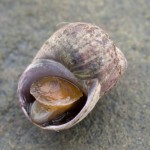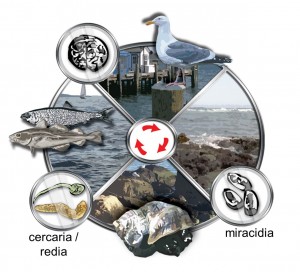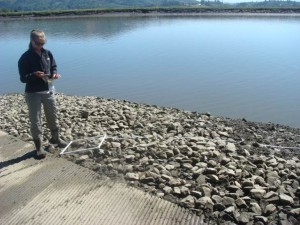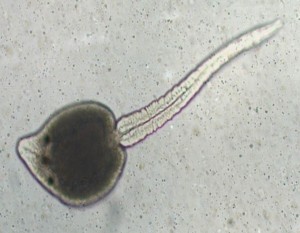by Monaca Noble

Invasion was a godsend for the rough periwinkle snail, which managed to escape its flatworm parasites. (World Register of Marine Species)
Take the common cat parasite Toxoplasma gondii. T. gondii‘s complex two-host life cycle makes it difficult for it to adapt to new places. The parasite has two phases, a sexual phase and an asexual phase. The sexual phase can only take place in the cat (primary host), but the asexual phase can occur in several mammal species (secondary host) including cats, mice, humans, and birds. Because the parasite must infect a cat to reproduce and survive, its preferred secondary host is a mouse. If a mouse infected with T. gondii were introduced into an area with no cats, the parasite would not be able to survive.
Then there are the snail-castrating trematodes. Trematodes are parasitic flatworms commonly called flukes. These parasites need to infect several different hosts in order to complete their life cycles. The snail is the parasite’s first host and is essential to the trematode life cycle. While inside the snail host, the trematode produces free-living larvae called cercariae. The cercariae then reproduce asexually inside the snail’s gonads, preventing the snail from reproducing – in effect castrating it. From the snail, the trematode infects a second host – a worm, crab, mussel, fish, or another snail – and then moves to a third host, called the “definitive host”, where it reproduces and completes its life cycle. This definitive host is usually a fish or a bird.

Trematode parasite life cycle. The snail is the first larval host, several species of fish are second larval hosts, and a seabird is the definitive host. Graphic by Raymond Houghton.
But that could all change if the snail finds a new home. Dr. April Blakeslee, a Research Associate and former Postdoctoral Fellow at the Smithsonian Environmental Research Center (SERC), led a study investigating how the “parasite escape hypothesis” operates in snails on both coasts of North America (published December 2011 in the Journal of Biogeography). In the study, she and her co-authors explored trematode parasite species of two snails, the eastern mudsnail (Ilyanassa obsoleta) and the rough periwinkle (Littorina saxatilis). Both snails are native to the east coast of the United States but were introduced to San Francisco Bay during the 20th century. Mudsnails were introduced through the importation of oysters during the early 1900s, and the periwinkle was introduced in the 1990s with algal packing material used to package seafood and baitworms.
Dr. Blakeslee and her team collected thousands of snails from sites on the east and west coasts. Mudsnails were collected from 49 east coast sites from Maine to Georgia and from sites in Willapa and Boundary Bays in Washington and San Francisco Bay. The periwinkles were collected from 29 sites from Newfoundland, Canada to Long Island, New York and again from San Francisco Bay. Following collection, Blakeslee’s team dissected the snails in lab to determine if any trematode parasites were present and, if so, what species. They used this information to calculate an index of parasite escape. In other words, they determined whether the snails actually had fewer parasites in their new homes than on their native shores.They found that both introduced periwinkles and mudsnails on the west coast had fewer parasites than the native ones on the east coast. However, the difference was much sharper in periwinkle snails than mudsnails. In fact, only 7 of the 1893 periwinkle snails sampled in the introduced San Francisco Bay region had trematode parasites.
The difference between the two species may be due to three important factors: the prevalence of parasites in the native region, the transport mechanism, and the time since introduction. Mudsnails were transported nearly a century earlier than the periwinkles (1900s vs 1990s). In addition, mudsnails were transported through the oyster trade as hitchhikers in the large shipments of oysters brought over to establish a west coast fishery, which occurred on a massive scale over several years. In contrast, the periwinkles were transported in algae used to pack fish and baitworms, and this method of introduction occurred on a much smaller scale. As a result, many fewer snails were released at any given time compared to the oyster trade.
Meanwhile on the native beaches, Blakeslee found that the prevalence of parasites was three times higher for the mudsnails than for the periwinkles. Taken together, all these factors mean there was a higher likelihood that a parasitized mudsnail was transported to the west coast than a parasitized periwinkle. But even with these differences, both species probably benefit from having fewer parasites in the introduced range.
Rough periwinkle snail image copyright of the World Register of Marine Species. Some rights reserved.



